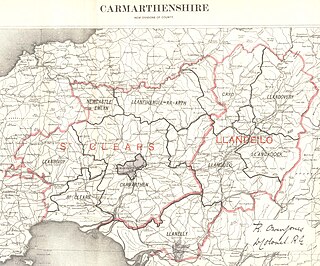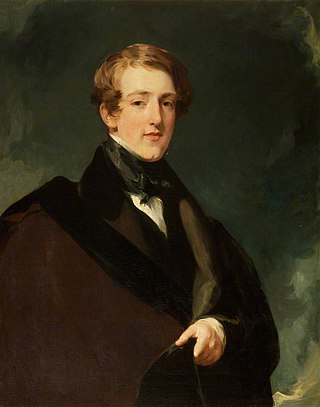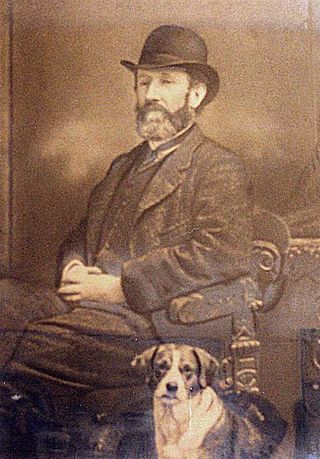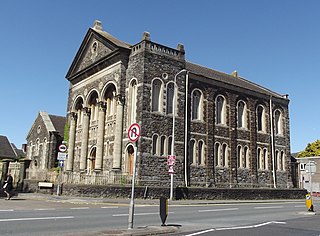
Llanelli is a market town and community in Carmarthenshire and the preserved county of Dyfed, Wales. It is located on the Loughor estuary and is also the largest town in the county of Carmarthenshire.
John Graham Chambers was a Welsh sportsman. He rowed for Cambridge, founded inter-varsity sports, became English Champion walker, coached four winning Boat-Race crews, devised the Queensberry Rules, staged the Cup Final and the Thames Regatta, instituted championships for billiards, boxing, cycling, wrestling and athletics, rowed beside Matthew Webb as he swam the English Channel and edited a national newspaper.

John Byrne Leicester Warren, 3rd Baron de Tabley was an English poet, numismatist, botanist and an authority on bookplates.

Llanelly House is one of the most notable historic properties in Llanelli, Carmarthenshire, Wales—an excellent example of an early-18th-century Georgian town house. It had been described as "the most outstanding domestic building of its early Georgian type to survive in South Wales."

East Carmarthenshire was a county constituency in Carmarthenshire, Wales. It returned one Member of Parliament (MP) to the House of Commons of the Parliament of the United Kingdom, elected by the first past the post voting system.

George Fleming Warren, 2nd Baron de Tabley PC was a British Liberal politician. He notably served as Treasurer of the Household under William Ewart Gladstone between 1868 and 1872.
Sir Edward Stafford Howard was a British Liberal politician and magistrate.
This is a list of High Sheriffs of Carmarthenshire. Carmarthenshire was originally created by the Statute of Rhuddlan in 1284. It became an administrative county in 1889 with a county council following the Local Government Act 1888. Under the Local Government Act 1972, the administrative county of Carmarthenshire was abolished on 1 April 1974 and the area of Carmarthenshire became three districts within the new county of Dyfed : Carmarthen, Dinefwr and Llanelli. Under the Local Government (Wales) Act 1994, Dyfed was abolished on 1 April 1996 and the three districts united to form a unitary authority which had the same boundaries as the original Carmarthenshire but remaining in the shrievalty of Dyfed.

Parc Howard Museum & Art Gallery is a museum in a 19th-century Italianate country house, situated in 24 acres (9.7 ha) of parkland, north of the town centre of Llanelli in Carmarthenshire, Wales. The park is registered on the Cadw/ICOMOS Register of Parks and Gardens of Special Historic Interest in Wales.
Slebech was a community in Pembrokeshire, Wales, which is now part of the combined community of Uzmaston and Boulston and Slebech, a sparsely populated community on the northern shore of the Eastern River Cleddau. The community shares boundaries with the communities of Wiston and Llawhaden and mainly consists of farmland and woodland. Much of the community is within the Pembrokeshire Coast National Park and Picton Castle's stable block loft is an important breeding roost for the rare Greater Horseshoe Bat.
Charles William Nevill was a Welsh owner of a copper smelting company in Llanelli, and a Conservative Party politician. He was elected at the 1874 general election as the Member of Parliament (MP) for Carmarthen Boroughs, but resigned from Parliament two years later, accepting the Stewardship of the Chiltern Hundreds in 1876.

The Cowell-Stepney Baronetcy, of Llanelli in the County of Carmarthen, was a title in the Baronetage of the United Kingdom. It was created on 22 September 1871 for John Cowell-Stepney, Member of Parliament for Carmarthen. Born John Cowell, he was the son of Andrew Cowell and Maria Justina Stepney, sister of Sir John Stepney, 8th Baronet, of Prendergast, and assumed the additional surname of Stepney on succeeding to the Stepney estates. The second Baronet also represented Carmarthen in Parliament. The title became extinct on his death in 1909.

The Stepney family are an English family, who having originated in Stepney, London, made their fortune in lands surrounding Llanelli, West Wales.

Sir Emile Algernon Arthur Keppel Cowell-Stepney, 2nd Baronet was a British landowner and Liberal politician. He was the youngest son of Sir John Stepney Cowell-Stepney (1791–1877).

Sir John Stepney Cowell-Stepney, 1st Baronet, KH (1791–1877) was a British soldier, landowner and politician. He was the elder of the two sons of General Andrew Cowell, originally of Coleshill, Buckinghamshire, and his wife Maria Justina, youngest daughter of Sir Thomas Stepney, 7th baronet of Prendergast, Pembrokeshire, and Llanelly House, Carmarthenshire. He was known as [John] Stepney Cowell until he inherited the Stepney family's estates in 1857 under the terms of the will of his uncle, Sir John Stepney, 8th baronet, when he changed the family's name to Cowell-Stepney.
The 1876 Carmarthen Boroughs by-election was fought on 14 August 1876. The by-election was called following the resignation of the incumbent Conservative MP, Charles William Nevill. It was won by the Liberal candidate Arthur Cowell-Stepney, who was returned unopposed.

Sir John Stepney, 8th Baronet, of Llanelli, Carmarthenshire, was a Welsh politician who sat in the House of Commons from 1767 to 1788.

Tabernacle Chapel is an Independent (Congregational) chapel in the town of Llanelli, Carmarthenshire, Wales. It was built in 1872 and is located at 17 Cowell Street. It is a Grade II* listed building.

Sir Thomas Stepney, 5th Baronet was a Welsh landowner and politician who sat in the House of Commons from 1717 to 1722.

Sir Albert de Rutzen was chief magistrate of the Metropolitan Police Courts in the United Kingdom. He was knighted in 1901.














